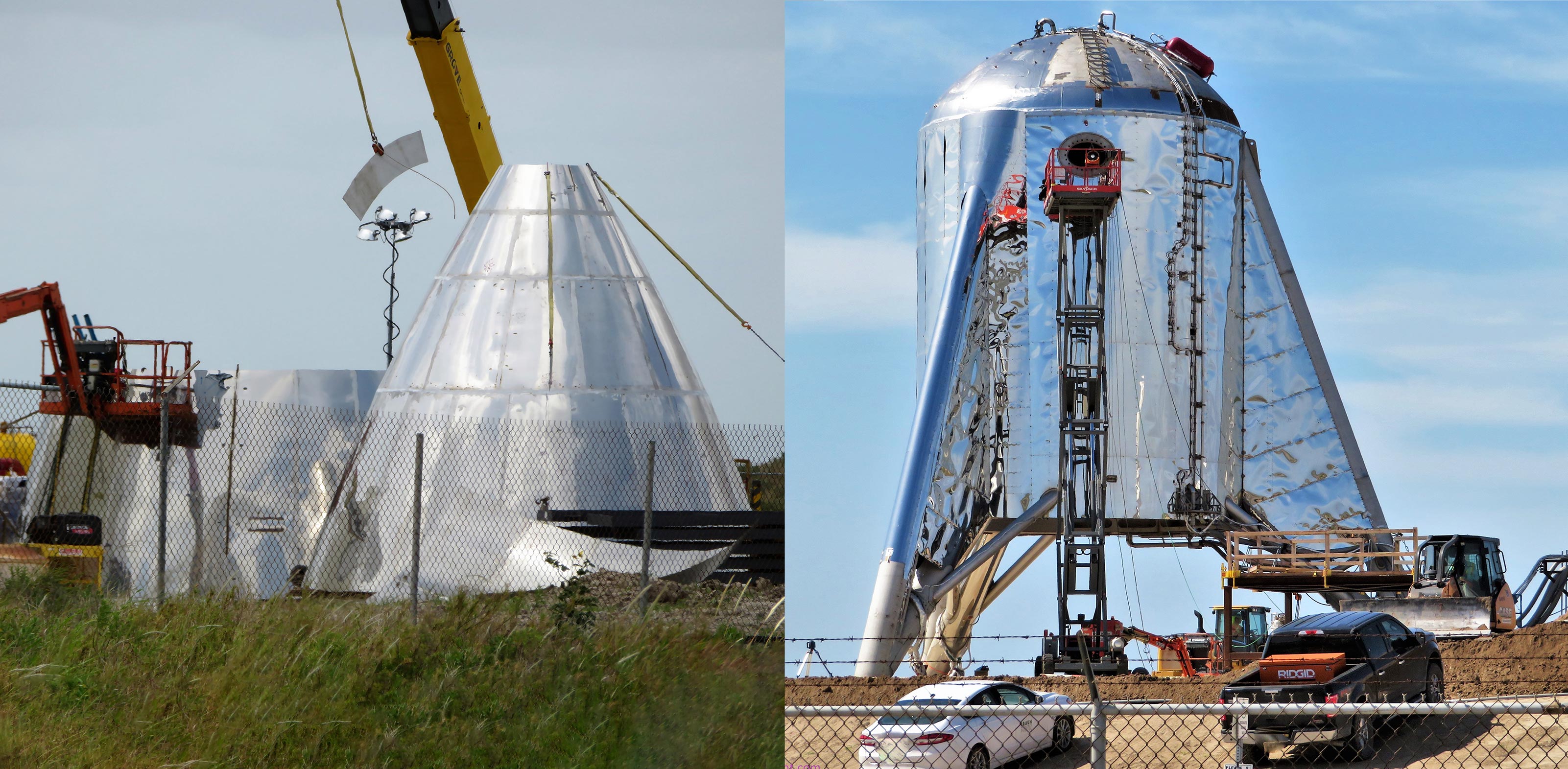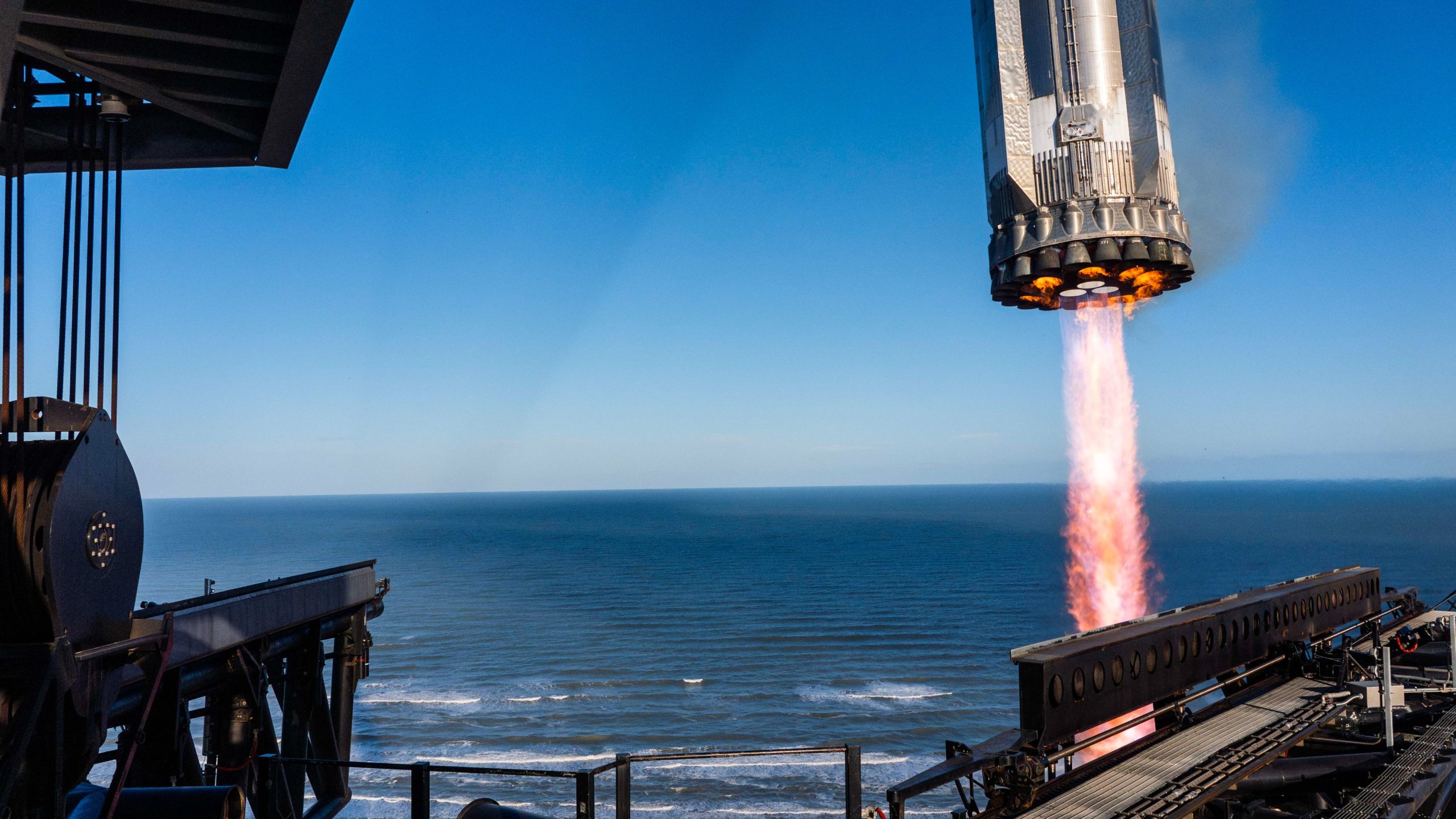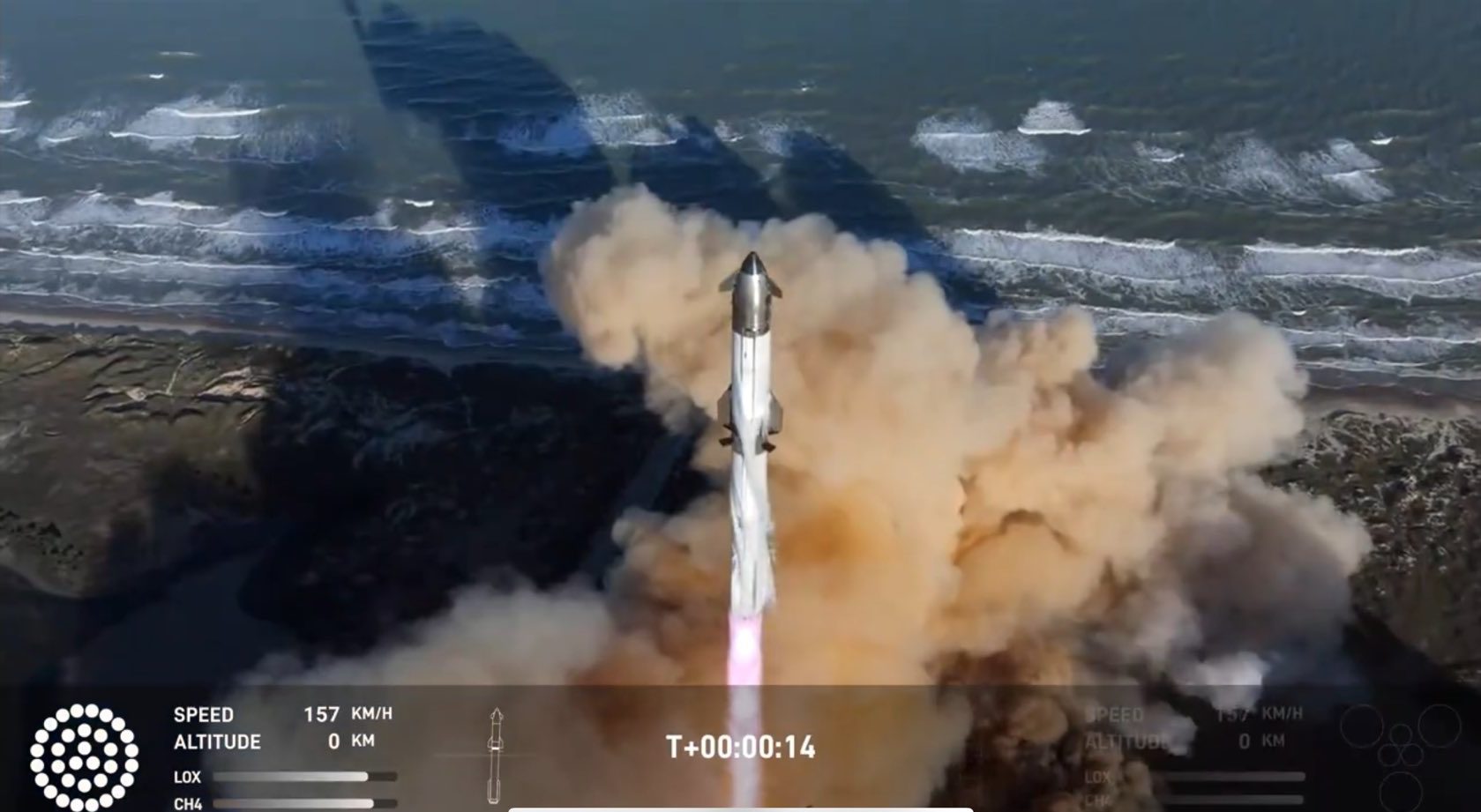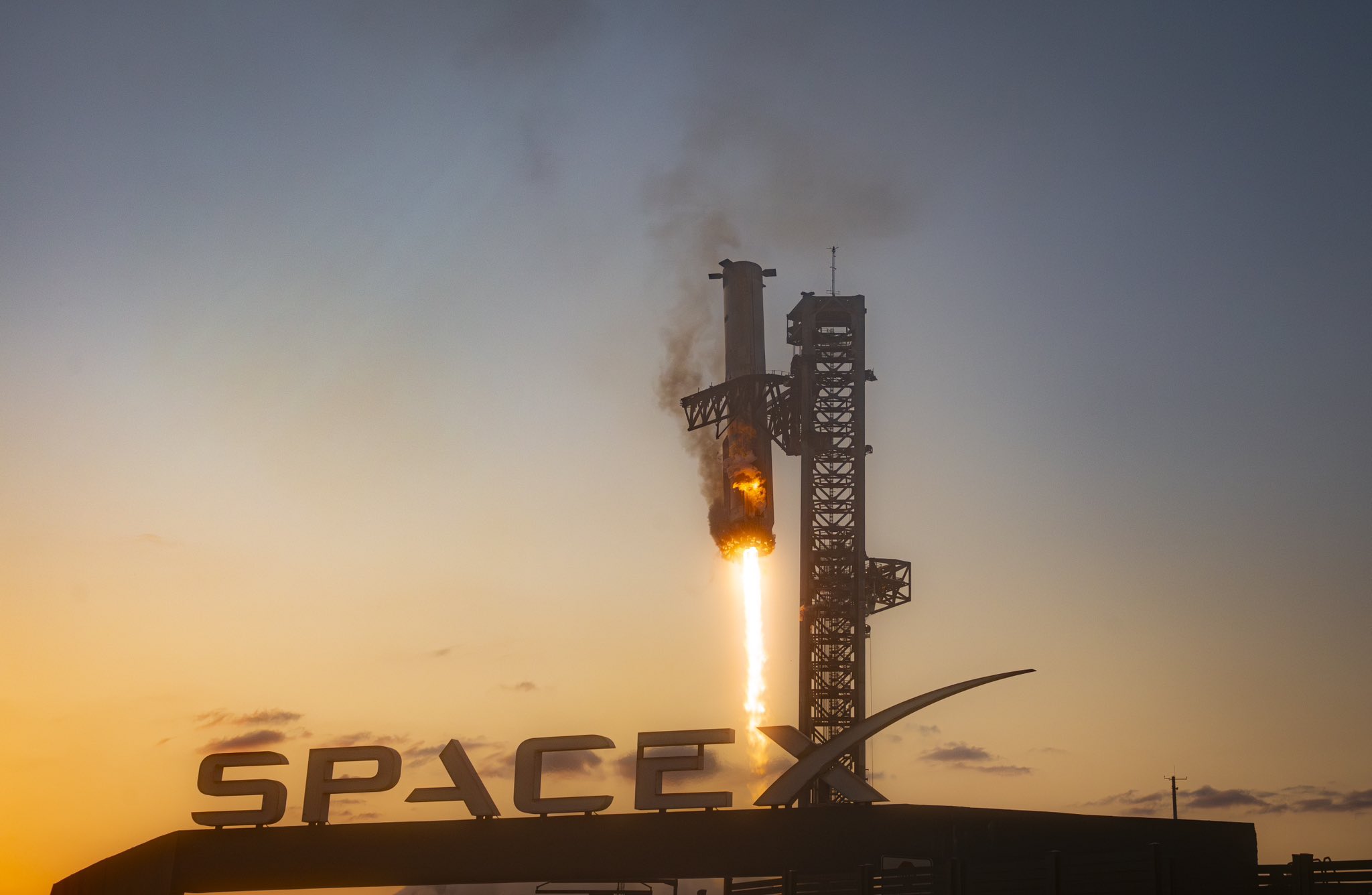

SpaceX
SpaceX’s Starship, Starhopper prototypes continue slow and steady progress
The last few weeks of SpaceX’s work on Starship and Starhopper prototypes has been marked by less visible progress relative to the past few months. The changes that are visible, however, confirm that its Boca Chica engineers are working around the clock to complete the first orbital Starship prototype.
At the same time, it appears that SpaceX’s South Texas facilities are preparing for a rapid period of expansion and build-up. New work around the ad-hoc Starhopper pad has recently begun, while construction of a second concrete jig for concurrent prototype fabrication and what will likely be a more permanent hangar and control facility are also ramping up. Things have been quiet news-wise for SpaceX’s McGregor and Hawthorne facilities but there is reason to believe that Raptor production and testing is going smoothly.
And over at its pal’s place, the orbital prototype (and the build-up of another jig)
— Chris B – NSF (@NASASpaceflight) April 20, 2019
📸@BocaChicaGal
Dedicated Updates: https://t.co/FYHRkwZ2dd pic.twitter.com/glg8Yr6oO6
Starship Alpha
The most obvious visible progress made in April is centers around SpaceX’s first orbital Starship prototype, soon to begin its third month of active construction. As of mid-March, the shells of two large steel barrel sections – together about 18 m (60 ft) tall – were fully erected at the build site, with a handful of other sections in various states of welding. The height of those two cylinders has remained unchanged since then but it’s safe to assume that a ton of work has been going on inside them, invisible to anyone viewing from public perspectives since drones were effectively banned in March. In other words, the two pieces – most likely the barrel sections of Starship’s liquid methane and liquid oxygen (LOX) tanks – are likely being carefully transformed into actual propellant tanks.

There is also a good reason for their height differential: the larger (LOX) section is almost exactly a third larger than the small section (methane) in part because of the physical reality that Starship will need almost exactly 33% more LOX than methane by volume. Large propellant tanks – particularly those meant for cryogenic fluids and spaceflight applications – are often quite complex, with the vast majority of that complexity happening under the hood. The above render was made while SpaceX was still planning on carbon fiber tanks and also appears to be significantly simplified, but it still offers a small look at some of that complexity.
Aside from successfully completing thousands of welds throughout the assembly, a lot of the effort of building an advanced tank is put into plumbing – both internal and external – needed to load, unload, pressurize, depressurize, and generally manage cryogenic (i.e. super cold) liquid propellant. SpaceX decided to utilize a partial balloon tank design to keep the steel skins of its stainless steel Starship and Super Heavy as thin as possible, adding yet another level of internal work due to the need for stringers and longerons on top of baffles and hardware to mount COPVs or header tanks.


Adding further complexity to the internal structure of Starship is the presence of major aerodynamic surfaces and landing legs, both of which will need to survive extreme stresses if they are to function as intended. Those structures must be aerodynamically streamlined and attach to the outside of Starship’s hull, likely requiring significant structural reinforcements both inside the spacecraft’s nose and rearmost propellant tank.
Super Heavy?
SpaceX began construction of a second concrete fabrication jig just a handful of days ago. Effectively a copy of a jig occupied with the larger of the two barrel sections of the orbital Starship prototype, the simple structure acts as a mount and includes a large door that allows scissor lifts to get inside the steel structure. The new jig is being built directly adjacent to Starship’s smaller barrel section, suggesting that it could simply be a way to concurrently work on both the LOX and methane tanks. Given the inherent simplicity of a concrete jig, it could also end up being used to support the simultaneous assembly and integration of the first Super Heavy booster prototype.
Back in December 2018, SpaceX CEO Elon Musk indicated that the first Super Heavy prototype would start production in “spring” (i.e. NET April 2019). Musk has also indicated that Starship and Super Heavy will be simultaneously built both in Boca Chica, Texas and Cape Canaveral, Florida. In general, SpaceX is clearly beginning another round of expansion and improvement for its Boca Chica facilities, including the new concrete jig and an entirely new building on the same plot of land.

Starhopper
Last but not least is SpaceX’s Starhopper prototype. After completing an inaugural round of multiple wet dress rehearsals (WDRs) and two Raptor static fires/hops, SpaceX technicians removed the vehicle’s lone Raptor engine on April 8th. Starhopper has remained more or less inactive in the last two weeks, aside from some work going on inside the vehicle (per the open access hatch).
Without a Raptor engine, there is admittedly not a whole lot that SpaceX can do with Starhopper, aside from additional WDRs if the first handful of tests were not enough. Instead, some minor work has been going on around the Hopper’s ad hoc pad, mainly taking the appearance of dirtmoving. Without aerial views, its hard to tell what exactly is taking shape, but it’s safe to say that Starhopper is simply waiting for additional Raptors to be produced, tested, and delivered to Boca Chica. Once more Raptors are ready, it’s understood that SpaceX will move into multi-engine (likely 3+) hop tests, perhaps loosing Starhopper from its tethers.
Check out Teslarati’s Marketplace! We offer Tesla accessories, including for the Tesla Cybertruck and Tesla Model 3.
News
SpaceX and Elon Musk explain potential reasons for Starship loss

SpaceX and its CEO Elon Musk are starting to shed some light on the potential reasoning for the loss of Starship yesterday, which was lost after a successful launch and catch of the lower-stage booster.
Starship was lost during its ascension, and debris rained down over the Caribbean less than an hour after SpaceX lost all communication with the spacecraft.
A few hours after the launch was over, SpaceX started to shed some light after looking at preliminary data that the rocket left behind.
The company said that a fire developed in the aft section of Starship:
“Following stage separation, the Starship upper stage successfully lit all six Raptor engines and performed its ascent burn to space. Prior to the burn’s completion, telemetry was lost with the vehicle after approximately eight and a half minutes of flight. Initial data indicates a fire developed in the aft section of the ship, leading to a rapid unscheduled disassembly with debris falling into the Atlantic Ocean within the predefined hazard areas.”
Additionally, Musk said that there was some sort of oxygen or fuel leak in the cavity above the ship engine firewall.
The leak was evidently large enough to build more pressure than the vent was able to handle:
🚨Elon Musk has also said an oxygen or fuel leak in the cavity above the ship engine firewall could be the cause of the anomaly. https://t.co/BgLkdA9Kk1
— TESLARATI (@Teslarati) January 17, 2025
Some also seemed to recognize evidence of fires throughout the flight of Starship, which is obviously an anomaly:
Unconfirmed but what looks to be fire at the hinge of Starship’s flap. A potential RUD? We await as we get any confirmation from SpaceX.
They do not have comms with the spacecraft as this moment. pic.twitter.com/Cn1EF4AHpv
— Mihir Tripathy (@mihirneal) January 16, 2025
There will be more information regarding the loss of Starship in the coming days and weeks, but Musk already believes that a bit of fire suppression and more volume in the cavity above the ship engine firewall could fix the issue.
“Nothing so far suggests pushing next launch past next month,” he said, so Flight 8 could happen sometime in February.
Need accessories for your Tesla? Check out the Teslarati Marketplace:
- https://shop.teslarati.com/collections/tesla-cybertruck-accessories
- https://shop.teslarati.com/collections/tesla-model-y-accessories
- https://shop.teslarati.com/collections/tesla-model-3-accessories
Please email me with questions and comments at joey@teslarati.com. I’d love to chat! You can also reach me on Twitter @KlenderJoey, or if you have news tips, you can email us at tips@teslarati.com.
News
SpaceX completes second catch of lower stage, but loses Starship

SpaceX completed its seventh launch of Starship on Thursday, accomplishing a clean liftoff and catch of the first-stage booster. However, the upper stage was lost after its ascent.
The launch took place just a few minutes after 5 p.m. on the East Coast, as the first attempts at getting Starship in the air for the seventh time were delayed by weather both last week and this week.
Conditions were favorable on Thursday as SpaceX looked to follow up a successful campaign by Blue Origin, Jeff Bezos’s company, earlier today.
SpaceX went into the seventh Starship launch with plans for a catch attempt of the first-stage booster, something it attempted and completed during the fifth test launch last year. It decided to skip a catch attempt with the sixth test flight as conditions were not aligned.
For now, SpaceX is extremely selective as to when it attempts catches.
However, it was successful during this attempt, its second completed catch:
🚨 🚀 Here is @SpaceX’s full catch of the Lower Stage Booster from Starship Flight 7! pic.twitter.com/IXIRAGr1Md
— TESLARATI (@Teslarati) January 16, 2025
This flight differed from previous launches as SpaceX rolled out several improvements to the rocket and the processes as it featured plans to do a Starlink deployment simulation and had various adjustments to flap placement and avionics.
These plans were disrupted by the fact that SpaceX lost all communications with Starship about ten minutes into the flight, which the aerospace company confirmed was a result of losing the spacecraft sometime during its ascent.
🚀🚨 Telemetry on Starship has been lost. All comms with the ship have been lost, and SpaceX’s livestream says this is an “anomaly.”
“We are assuming the ship has been lost.” pic.twitter.com/fyyCNuXVRg
— TESLARATI (@Teslarati) January 16, 2025
Although the catch was successful, the loss of the actual rocket seemed to be a huge damper on the entire event. SpaceX confirmed several minutes after the loss of communications that the rocket was destroyed and was lost.
It was its first failure since the second Starship launch in November 2023. SpaceX had no answers for why the rocket was destroyed and lost.
We will keep you updated in the coming days.
Need accessories for your Tesla? Check out the Teslarati Marketplace:
- https://shop.teslarati.com/collections/tesla-cybertruck-accessories
- https://shop.teslarati.com/collections/tesla-model-y-accessories
- https://shop.teslarati.com/collections/tesla-model-3-accessories
Please email me with questions and comments at joey@teslarati.com. I’d love to chat! You can also reach me on Twitter @KlenderJoey, or if you have news tips, you can email us at tips@teslarati.com.
News
SpaceX confirms next Starship launch target – Here’s when it will take off

SpaceX has confirmed a new target date for the seventh Starship test launch after weather in Texas delayed the first scheduled date for “three or four days.”
The company is now targeting the launch for Monday, January 13, at 4 p.m. CST or 5 p.m. EST. The launch date is not set in stone as any variety of delays could impact this, but SpaceX hopes to finally take off after a delay that pushed it back from January 10.
🚨 STARSHIP LAUNCH DATE: @SpaceX says Starship’s 7th test flight is now targeted for Monday, January 13 at 4pm CST
— TESLARATI (@Teslarati) January 8, 2025
What’s new with this Starship launch
With this being the seventh test launch of Starship, there are several things that the company will change and hope to accomplish. All of these launches are done in preparation for eventually taking flight to Mars, something that will happen next year, according to CEO Elon Musk.
First, SpaceX is rolling out a next-generation ship with “significant upgrades.” Forward flaps have been made smaller and are repositioned away from the heat shield, which will “reduce their exposure to reentry heating.”
There is also a 25 percent increase in propellant volume, a new fuel feedline system for the Raptor vacuum engines, and a better-than-ever propulsion avionics module that will control the valves and reading sensors.
Avionics, as a whole, underwent a redesign and now have more capability and redundancy for missions as they become more complex.
Starlink test
SpaceX is also planning to deploy 10 Starlink simulators that are similar in size and weight to the next-generation Starlink satellites:
“While in space, Starship will deploy 10 Starlink simulators, similar in size and weight to next-generation Starlink satellites as the first exercise of a satellite deploy mission. The Starlink simulators will be on the same suborbital trajectory as Starship, with splashdown targeted in the Indian Ocean. A relight of a single Raptor engine while in space is also planned.”
Ship return and catch
There will be several experiments that have to do with returning Starship and various catch scenarios and sequences. One of which will see “a significant number of tiles be removed to stress-test vulnerable areas across the vehicle.”
The ship’s reentry profile was also intentionally designed to test the structural limits of the flaps while at the point of maximum dynamic pressure during reentry.
Currently, SpaceX did not detail whether it would attempt another catch during this test launch. These are usually game-time decisions.
Need accessories for your Tesla? Check out the Teslarati Marketplace:
- https://shop.teslarati.com/collections/tesla-cybertruck-accessories
- https://shop.teslarati.com/collections/tesla-model-y-accessories
- https://shop.teslarati.com/collections/tesla-model-3-accessories
Please email me with questions and comments at joey@teslarati.com. I’d love to chat! You can also reach me on Twitter @KlenderJoey, or if you have news tips, you can email us at tips@teslarati.com.


















